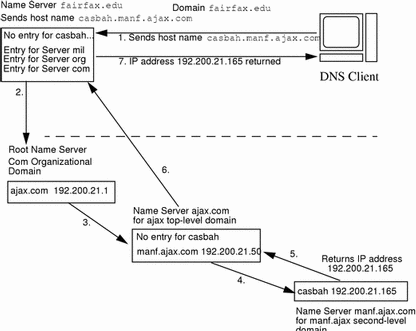Name-to-Address Resolution
Though it supports the complex, world-wide hierarchy of computers on the Internet, the basic function of DNS is actually very simple: providing name-to-address resolution for TCP/IP-based networks. Name-to-address resolution, also referred to as "mapping," is the process of finding the IP address of a computer in a database by using its host name as an index.
Name-to-address mapping occurs when a program running on your local machine needs to contact a remote computer. The program most likely will know the host name of the remote computer but may not know how to locate it, particularly if the remote machine is in another company, miles from your site. To get the remote machine's address, the program requests assistance from the DNS software running on your local machine, which is considered a DNS client.
Your machine sends a request to a DNS name server, which maintains the distributed DNS database. The files in the DNS database bear little resemblance to the NIS+ Host Table or even the local /etc/hosts file, though they maintain similar information: the host names, IP addresses, and other information about a particular group of computers. The name server uses the host name your machine sent as part of its request to find or "resolve" the IP address of the remote machine. It then returns this IP address to your local machine IF the host name is in its DNS database.
Figure 27-1 shows name-to-address mapping as it occurs between a DNS client and a name server, probably on the client's local network.
Figure 27-1 Name to Address Resolution

If the host name is not in that name server's DNS database, this indicates that the machine is outside of its authority, or, to use DNS terminology, outside the local administrative domain. Thus, each name server is spoken of as being "authoritative" for its local administrative domain.
Fortunately, the local name server maintains a list of host names and IP addresses of root domain name servers, to which it will forward the request from your machine. These root name servers are authoritative for huge organizational domains, as explained fully in "DNS Hierarchy and the Internet". These hierarchies resemble UNIX file systems, in that they are organized into an upside-down tree structure.
Each root name server maintains the host names and IP address of top level domain name servers for a company, a university, or other large organizations. The root name server sends your request to the top-level name servers that it knows about. If one of these servers has the IP address for the host you requested, it will return the information to your machine. If the top-level servers do not know about the host you requested, they pass the request to second-level name servers for which they maintain information. Your request is then passed on down through the vast organizational tree. Eventually, a name server that has information about your requested host in its database will return the IP address back to your machine.
Figure 27-2 shows name-to-address resolution outside the local domain.
Figure 27-2 Name to Address Resolution for a Remote Host

- © 2010, Oracle Corporation and/or its affiliates
